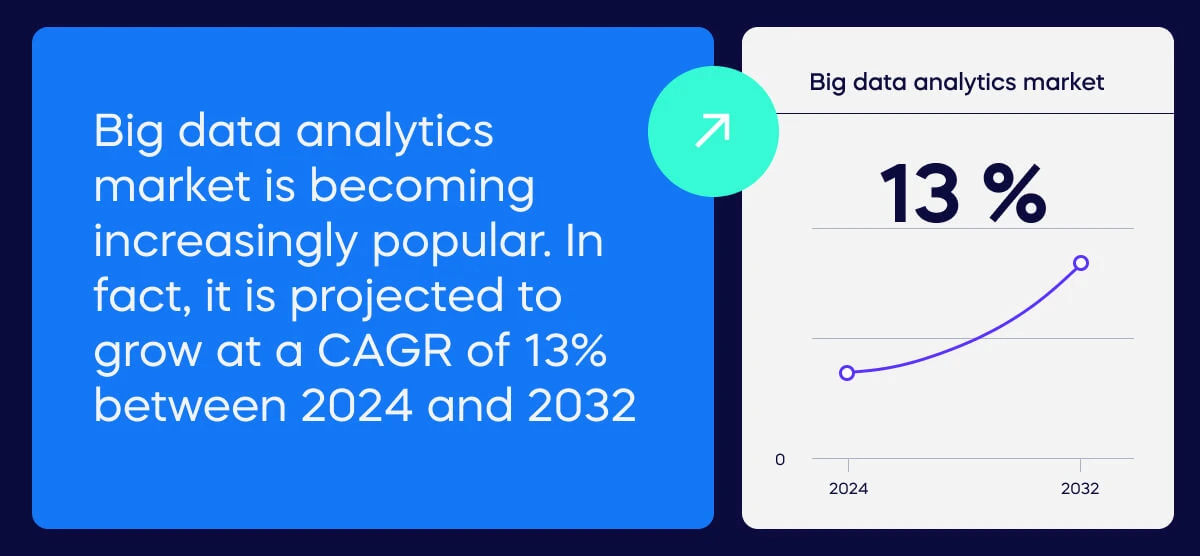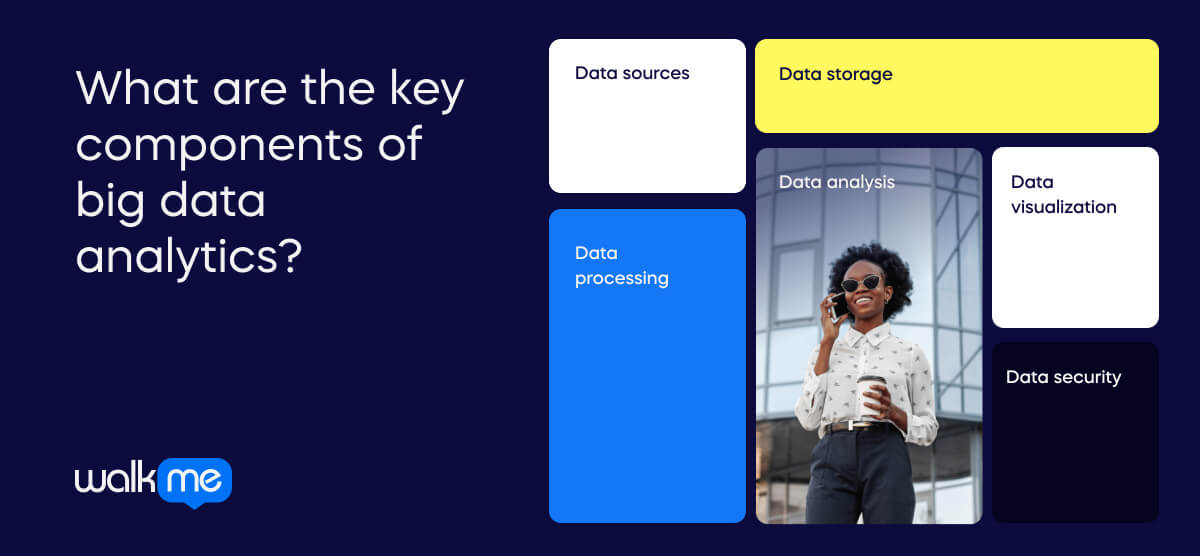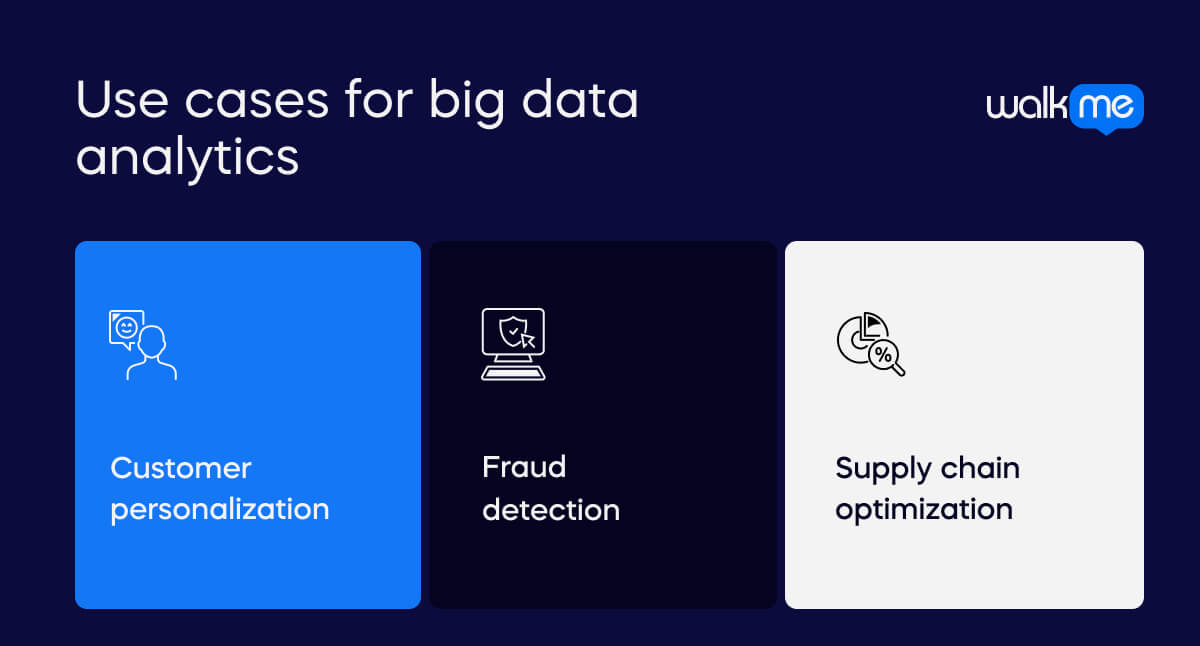What is big data analytics?
Big data analytics is the process of examining huge amounts of information to find useful patterns and insights. Unlike smaller data that is easy to manage, big data comes from many different sources, such as social media, sensors, and online transactions.

Handling and understanding this massive amount of data requires special tools and methods. The main purpose of big data analytics is to help organizations make better decisions and improve their performance. Businesses can spot trends and patterns that aren’t obvious in smaller data sets using advanced techniques. For example, a store might analyze customer buying habits to predict what products will be popular in the future or to better manage stock. Big data analytics is important in many fields, such as healthcare and finance, because it helps organizations obtain important information and drive new ideas. In healthcare, studying patient data can help find better treatments. In finance, it can help catch fraud and manage risks. Overall, big data analytics turns large amounts of information into valuable knowledge. An increasing number of businesses have shared that they believe they’re using data effectively. Over 75% of respondents said they were championing innovation with data, and 50% believe their business competes on data and analytics.

The market itself is also becoming increasingly popular. In fact, it is projected to grow at a CAGR of 13% between 2024 and 2032.
What are the key components of big data analytics?

Knowing the key parts of big data analytics helps one understand how it turns large amounts of data into useful information. Each part plays a big role in managing, analyzing, and protecting the data. These parts work together to ensure that data is stored, cleaned, and analyzed properly to give clear and helpful results. Let’s look at the main parts that make big data analytics work well.
Data sources
These are places where data comes from, like social media, sensors, and online purchases. They provide the basic information for analysis. Different sources offer different types of data, helping to see a wider range of trends and behaviors.
Data storage
This is about keeping large amounts of data safe and accessible. It uses tools like cloud storage to manage the data. Good storage helps quickly find and use the data when needed.
Data processing
This step involves cleaning and organizing the data so it’s ready for analysis. It makes the data accurate and easy to use. Proper processing is important for getting reliable results.
Data analysis
Here, the data is examined to find patterns or insights. It uses methods like statistics or machine learning. Analyzing the data helps make better decisions based on what is found.
Data visualization
After analysis, the results are shown in charts or graphs. This makes it easier to understand the findings. Good visuals help people see and use the information more clearly.
Data security
This ensures the data is protected from unauthorized access or theft. It involves using security measures to keep the data safe. Strong security helps keep sensitive information secure and trustworthy.
Big data analytics vs data analytics vs data science
Big data analytics, data analytics, and data science all work with data but do different things.
- Big data analytics looks at huge amounts of data from many sources.
- Data analytics examines smaller amounts of data to find trends and help make decisions.
- Data science uses data analysis, statistics, and machine learning to build models and predict future trends.
Let’s look at how these three are different.
| Big data analytics | Data analytics | Data science | |
| Definition | Looks at very large and complex data sets from many sources to find useful patterns and insights. It deals with huge amounts of data that are too big for regular methods. | Examines data to understand what it shows. It can handle small to medium-sized data and helps find trends and make decisions. | A broad field that uses data analysis, statistics, and machine learning to learn from data. It builds models and algorithms to predict future trends. |
| Focus | Managing and analyzing very large amounts of data from various sources, often in real-time. | Analyzing data to find patterns and trends, with data that may not be as large or complex. | Creating methods and models to understand and predict data, combining data analysis with computer science and statistics. |
| Techniques | Uses methods like distributed computing and real-time processing to handle and analyze large data sets. | Uses techniques like statistical analysis and data visualization to find insights from data. | Uses methods from statistics and machine learning to build models and predict future trends. It often involves programming. |
| Goals | Make sense of massive data sets to find useful insights and trends for better decision-making. | Understand data to help make decisions and solve problems based on trends. | Build models and algorithms to understand data and predict future outcomes. |
| Examples of use | Used by companies like Amazon and Google to analyze customer behavior and improve recommendations. | Used by businesses to look at sales data and understand customer preferences. | Used in healthcare to predict disease outbreaks or in finance to find fraud using machine learning. |
Use cases for big data analytics

Big data analytics can be very helpful in different business situations. It can make recommendations for customers, help find fraud, and improve product delivery. Seeing how big data analytics works in these areas can show how it helps businesses run better and stay secure. Here are three examples of how big data analytics is used in different business cases.
Customer personalization
Customer personalization helps businesses offer products that match each person’s interests. Big data analytics collects information from different sources, such as what people look at online and what they buy. It then uses this information to suggest products they might like. This makes shopping more enjoyable and can lead to more sales.
Fraud detection
Fraud detection helps companies find and stop fraud. Big data analytics analyzes transaction data from places like credit card purchases to spot strange patterns. Quickly checking these patterns can warn the company about possible fraud, protecting the company and its customers from losing money.
Supply chain optimization
Supply chain optimization helps companies better manage their products and deliveries. Big data analytics tracks products from suppliers to customers. It checks this data to predict how much is needed, find delays, and choose the best delivery routes. This keeps products on time and cuts costs by avoiding too much or too little stock.
What are the advantages of big data analytics?
Big data analytics has many advantages for businesses. By looking at large amounts of data, companies can find useful insights that help them make better choices and improve their work. This leads to happier customers, smoother operations, and more successful strategies. Let’s explore the different benefits big data analytics can offer a business.
Improves decision making
Businesses make better decisions by showing clear insights from large amounts of data. Big data analytics finds patterns that might not be easy to see otherwise, helping companies make choices based on real facts. This leads to smarter decisions and helps avoid costly mistakes. Over time, it allows the business to run more smoothly and stay ahead of others.
Increases efficiency
It helps find ways to make business operations better. It can show where there are delays or problems, like in supply chains, helping companies work faster and save money. Fixing these issues means businesses can get more done with less effort. This boost in efficiency helps companies use their resources better.
Enhances customer experience
Businesses can offer personalized recommendations and services by looking at what customers like and do. This makes interactions more relevant and enjoyable for customers, leading to higher satisfaction and loyalty. Personalization also keeps customers coming back and can lead to more sales. It makes customers feel valued and understood.
Detects fraud quickly
It helps find fraud by looking for unusual patterns in transaction data. Spotting fraud early helps prevent financial losses and keeps the business and its customers safe. Finding fraud quickly means problems can be fixed before they get worse. This approach helps in maintaining security and trust.
Boosts innovation
Big data analytics finds new ideas by looking at market trends and customer needs. This helps companies create new products or improve existing ones. Staying ahead with fresh ideas keeps businesses competitive and supports growth. Data-driven innovation helps companies adapt to changing markets.
Optimizes marketing campaigns
Businesses can see which marketing efforts are most effective. Big data analytics tracks different campaigns’ performance and finds the right audience, improving the return on investment (ROI). This helps companies make smarter marketing decisions and use their budgets better. This analysis results in more successful campaigns.
Enhances risk management
It helps spot potential risks and threats early. This lets businesses address problems before they become big issues, improving overall risk management. Understanding risks ahead of time helps in making decisions to protect the company. Good risk management keeps the business’s assets and reputation safe.
Supports better forecasting
Big data analytics helps businesses predict future trends by analyzing past data and patterns. This makes planning for future needs, sales, and market changes easier. Better forecasting leads to smarter planning and resource use. Accurate predictions help businesses be prepared and adjust quickly to changes.
What are the challenges of big data analytics?
While analyzing large amounts of data can provide useful insights, it also brings several problems. Understanding these issues helps businesses prepare for them and find ways to solve them. Let’s explore the main difficulties related to big data analytics.
Data privacy concerns
Handling large amounts of data can be tricky when keeping personal information safe. It can also be challenging to ensure data is protected from unauthorized access. Companies must follow strict rules and use special tools to keep everything secure.
High costs
Setting up and running big data analytics systems can be very expensive. Costs include buying powerful equipment and software and hiring skilled workers. These expenses can be tough for smaller businesses with limited budgets.
Complexity of analysis
Analyzing large data sets can be difficult and requires advanced tools and methods. Understanding the data and making it useful often requires experts, which can be challenging for businesses without the right skills or resources.
Data quality issues
Big data analytics depends on accurate and clean data. Poor or incorrect data can lead to wrong conclusions and bad decisions. Companies must spend time and effort cleaning and checking their data to ensure reliability.
How can DAPs help with big data analytics?
Digital adoption platforms can greatly help with big data analytics. Businesses using a DAP can improve how they handle and understand large amounts of data. The platform provides tools and support to get the best results from big data. Let’s see how DAPs make big data analytics more effective and useful for businesses.
Streamlined data integration
Digital adoption platforms make connecting and combining data from different sources easier. They provide tools and help gather all the data into one place, ensuring that all data is ready and organized for analysis.
User training and guidance
These platforms offer training and support to help users learn how to use big data tools. They provide simple lessons and guides on how to use the features. They are also available to answer questions and solve problems, making it easier for users to use the tools.
Improved data visualization
Digital adoption platforms help create easy-to-read charts and graphs from complex data. This makes it simpler for users to see patterns and understand their data, and clear visualizations help users make better decisions.
Enhanced user experience
They improve users’ interactions with big data tools by providing easy-to-use interfaces. This makes it simpler for users to find and use the information they need. A better user experience helps users work more efficiently and gain useful insights from their data.